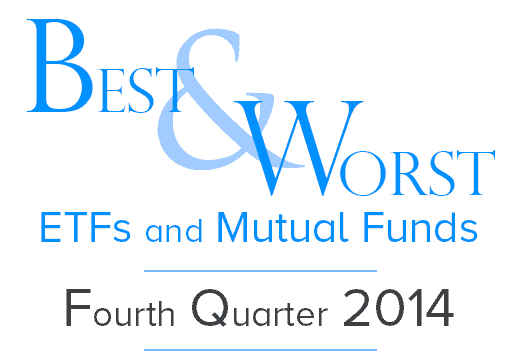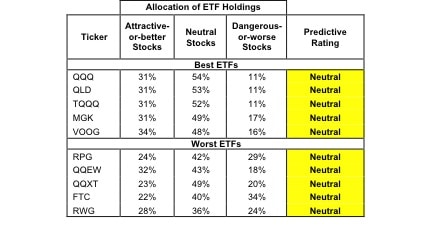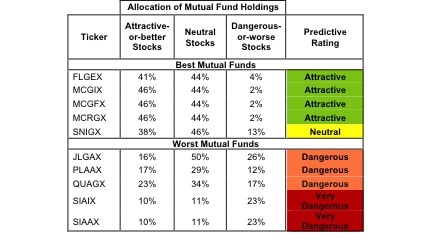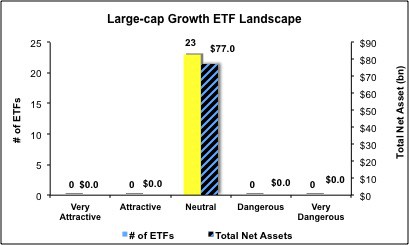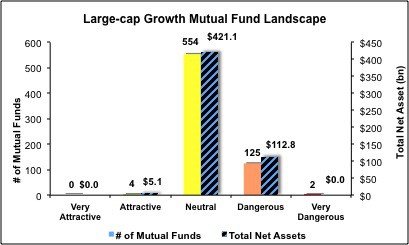The Large Cap Growth style ranks fourth out of the twelve fund styles as detailed in my Style Rankings for ETFs and Mutual Funds report. It gets my Neutral rating, which is based on aggregation of ratings of 23 ETFs and 685 mutual funds in the Large Cap Growth style as of July 12, 2013. Prior reports on the best & worst ETFs and mutual funds in every sector and style are here.
Figures 1 and 2 show the five best and worst-rated ETFs and mutual funds in the style.
Not all Large Cap Growth style ETFs and mutual funds are created the same. The number of holdings varies widely (from 19 to 611), which creates drastically different investment implications and ratings. The best ETFs and mutual funds allocate more value to Attractive-or-better-rated stocks than the worst, which allocate too much value to Neutral-or-worse-rated stocks.
To identify the best and avoid the worst ETFs and mutual funds within the Large Cap Growth style, investors need a predictive rating based on (1) stocks ratings of the holdings and (2) the all-in expenses of each ETF and mutual fund. Investors need not rely on backward-looking ratings. My fund rating methodology is detailed here.
Investors should not buy any Large Cap Growth ETFs or mutual funds because none get an Attractive-or-better rating. If you must have exposure to this style, you should buy a basket of Attractive-or-better rated stocks and avoid paying undeserved fund fees. Active management has a long history of not paying off.
Get my ratings on all ETFs and mutual funds in this style on my free mutual fund and ETF screener.
Figure 1: ETFs with the Best & Worst Ratings – Top 5
* Best ETFs exclude ETFs with TNAs less than $100 million for inadequate liquidity.
Sources: New Constructs, LLC and company filings
Figure 2: Mutual Funds with the Best & Worst Ratings – Top 5
* Best mutual funds exclude funds with TNAs less than $100 million for inadequate liquidity.
Sources: New Constructs, LLC and company filings
Power Shares QQQ (QQQ) is my top-rated Large Cap Growth ETF and Fidelity Large Cap Growth Enhanced Index Fund (FLGEX) is my top-rated Large Cap Growth mutual fund. QQQ, like all Large Cap Growth ETFs, gets my Neutral rating, while FLGEX gets my Attractive rating.
Columbia Large Cap Growth Equity Strategy Fund (RWG) is my worst-rated Large Cap Growth ETF and Snow Capital Inflation Advantaged Equities Fund (SIAAX) is my worst-rated Large Cap Growth mutual fund. RWG gets my Neutral rating, while SIAAX earns my Very Dangerous rating.
Figure 3 shows that 211 out of the 949 stocks (over 26% of the market value) in Large Cap Growth ETFs and mutual funds get an Attractive-or-better rating. However, zero out of 23 Large Cap Growth ETFs and 4 out of 685 Large Cap Growth mutual funds (less than 1% of total net assets) get an Attractive-or-better rating.
The takeaways are: mutual fund managers allocate too much capital to low-quality stocks and Large Cap Growth ETFs hold poor quality stocks.
Figure 3: Large Cap Growth Style Landscape For ETFs, Mutual Funds & Stocks
Sources: New Constructs, LLC and company filings
As detailed in “Low-Cost Funds Dupe Investors”, the fund industry offers many cheap funds but very few funds with high-quality stocks, or with what I call good portfolio management.
Investors need to tread carefully when considering Large Cap Growth ETFs and mutual funds, as only mutual funds in this style offer any Attractive prospects. No ETFs and 4 mutual funds in the Large Cap Growth style allocate enough value to Attractive-or-better-rated stocks to earn an Attractive rating.
Medtronic Inc. (MDT) is one of my favorite stocks held by Large Cap Growth ETFs and mutual funds and earns my Attractive rating. Medtronic has grown profits (NOPAT) by over 14% compounded annually since the beginning of my model in 1998. MDT also has a return on invested capital of 13%, up from 8% in 2000. Although MDT has grown steadily larger and more profitable since 1998, it is still relatively inexpensive at ~$54/share. This price gives MDT a price to economic book value ratio of 0.9, which means that the market expects its profits to permanently decline by 10%. Judging by Medtronic’s profit growth over the last 15 years, it looks more likely that MDTs profits will increase rather than decrease in the near future. Investors should pick up MDT while it still trades at its current discount.
Hartford Financial Services Group (HIG) is one of my least favorite stocks held by Large Cap Growth ETFs and mutual funds and earns my Dangerous rating. HIG’s profits (NOPAT) have fallen 9% compounded annually since 1998, from $1.1 billion to less than $270 million in 2012. HIG also has a return on invested capital (ROIC) of less than 1%, which puts it in the bottom quintile of all companies I cover. Despite its poor profit history, HIG’s valuation is expensive. To justify its current stock price, Hartford must grow profits 10% compounded annually for the next 16 years. Those expectations are awfully high for a company whose profits have declined steeply over the past 15 years. Investors should avoid HIG.
Figures 4 and 5 show the rating landscape of all Large Cap Growth ETFs and mutual funds.
My Style Rankings for ETFs and Mutual Funds report ranks all styles and highlights those that offer the best investments.
Figure 4: Separating the Best ETFs From the Worst Funds
Sources: New Constructs, LLC and company filings
Figure 5: Separating the Best Mutual Funds From the Worst Funds
Sources: New Constructs, LLC and company filings
Review my full list of ratings and rankings along with reports on all 23 ETFs and 685 mutual funds in the Large Cap Growth style.
André Rouillard and Sam McBride contributed to this report.
Disclosure: David Trainer, André Rouillard and Sam McBride receive no compensation to write about any specific stock, sector, style or theme.
